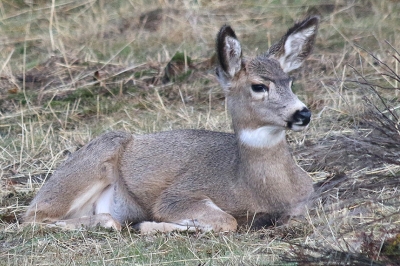
Revised Mule Deer Management Plan coming in 2023-24
Hunters who want to know more about Oregon’s mule deer management should sign up to receive updates and provide input on the ODFW administrative web site:

The state’s Mule Deer Management Plan was last revised in 2003. Some big themes ODFW staff are working on in the revised plan include:
Focus on herd ranges rather than WMUs
Oregon’s 67 wildlife management units (WMUs) were originally established in the 1950s. Their boundaries don’t necessarily align with mule deer behavior, as many deer herds summer in one unit and winter in another.
Recent data from mule deer fitted with GPS radio collars from across their range in Oregon provides a more informed understanding of how populations are distributed on summer, winter, and migratory habitats across eastern Oregon. The updated Plan uses this data as the basis to introduce more biologically meaningful herd ranges, which will replace WMUs as the monitoring unit for mule deer management in Oregon.
Herd ranges will include multiple WMUs that represent summer range, winter range and migratory routes for mule deer populations. This delineation of herd ranges (so that survey data collecting during winter applies to the same populations as hunter harvest reports from summer-autumn) is critical for developing appropriate management recommendations.
WMUs will remain the principal unit for managing mule deer harvest and providing hunting tags.
“We’ll be managing at a larger scale than wildlife management units based on research that shows deer are more interconnected across multiple units,” says Josh Smith, ODFW Mule Deer Coordinator.
ODFW is also working with a vendor (SpeedGoat) to develop an integrated population model based on the research. Current surveys occur in varying conditions and can result in large swings in numbers of deer observed and the population estimate, which the integrated model will help correct. The model will combine multiple data types into a single, integrated analysis of abundance and demographic processes that will allow ODFW manage mule deer more effectively
Stressing summer habitat
For many years, wildlife managers and conservationists have stressed the need to protect big game winter range—low elevation habitat they need to survive the winter. The Plan will take a closer look at the critical role summer range plays in mule deer survival. Researchers and biologists have more understanding of how forage conditions during spring and summer are impacting mule deer. Without enough nutrition during summer to make it to winter range in decent body condition, mule deer are unable to sustain pregnancies and fawns and are more vulnerable to severe weather, predation and disease. Unfortunately, the quality and quantity of mule deer forage has declined in Oregon.
Accounting for climate change
A recent study in the Starkey Experiment Forest is well, stark. Researchers compared current data on plots during spring growing seasons to data collected in the 90s. Spring growing seasons have declined by 2-3 weeks and the duration of shrub senescence (period without growth) has increased by three weeks. In effect, the growing season has decreased by a month, depriving mule deer of needed forage. Information in the Mule Deer Plan will discuss observed and expected impacts of climate change and suggest ways to mitigate the worst impacts.
Enhancing habitat after fire
Wildfires are becoming larger and more common. Fires can be beneficial for mule deer habitat as they create more young growth and forage, provided invasives like Medusahead rye and cheat grass don’t get a foothold first. The Plan will look at options for increasing habitat enhancements so fires actually benefit mule deer habitat.
Addressing migration corridors
The study with GPS collars also shed more light on mule deer migration and the pinch points where more deer are dying in vehicle collisions. The Infrastructure Bill passed by Congress in 2021 is providing $350 million to the states for wildlife crossings and other mitigation and ODFW’s Mule Deer Plan will look at how best to use Oregon’s portion of that investment.

